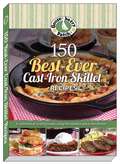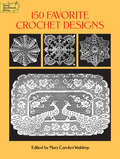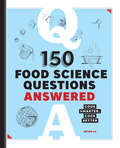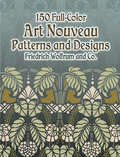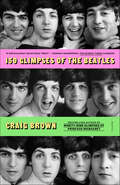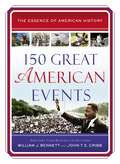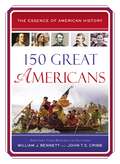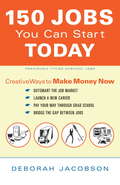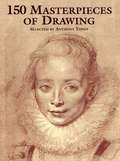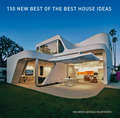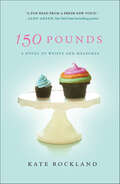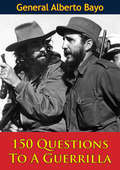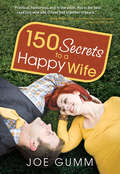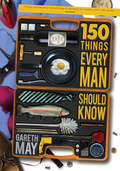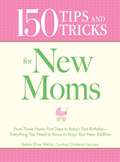- Table View
- List View
150 Best-Ever Cast Iron Skillet Recipes
by Gooseberry PatchBest known for their collection of family-friendly, community-style cookbooks. Each Gooseberry Patch cookbook is created with today's time-strapped, budget-conscious families in mind and filled with recipes shared by cooks all across the country. Along with treasured family recipes, each book includes the stories the go along with these tried & true dishes.With more than 220 titles and over 9 million copies in print, plus an ever-growing collection of eBooks, Gooseberry Patch has grown from a kitchen-table operation to a nationally recognized best-selling published brand. "I always buy a Gooseberry Patch cookbook for bridal showers. New cooks and seasoned pros alike can find something to please their families on the pages of Gooseberry Patch!" ~ Wendy from Waynesville, NC
150 Favorite Crochet Designs (Dover Knitting, Crochet, Tatting, Lace)
by Mary Carolyn WaldrepThis rich treasury of popular crochet designs, selected from vintage thread company leaflets, includes 150 patterns favored by crocheters during the first half of the 20th century. Included are eye-catching designs for creating a host of attractive domestic accessories: tablecloths, bedspreads, doilies, edgings, and other pieces. All designs are accompanied by a complete list of necessary materials, while detailed row-by-row instructions guide beginning and advanced needleworkers through each step of the crocheting process.Choose from heirloom-quality patterns including lovely lace edgings that will bring a touch of glamour to table linens, bedcovers, and the necklines of sweaters and blouses. You'll find a simple yet elegant Main Line tablecloth, revealing a charming filet-crochet motif of floral and foliated designs; a splendid bedspread composed of dainty diamond- and octagon-shaped motifs; and a wealth other attractive patterns.With this inexpensive collection at your fingertips you can be sure of finding the project that's just right for you. Best of all, expert instructions make it easy to create beautiful crocheted pieces you'll cherish for years to come.
150 Food Science Questions Answered: Cook Smarter, Cook Better
by Bryan LeCooking isn't just an art, it's a science—150 fascinating food facts to make you a better cook Does cold water come to a boil faster than warm water? Why does fat taste so good? What makes popcorn pop? Most of the processes that occur during cooking are based on principles found in biology, chemistry, and physics. 150 Food Science Questions Answered is an intriguing look into the science of food, from the eyes of a food science Ph.D. candidate and recipient of the James Beard Legacy Scholarship. Learn food science—how controlling heat, moisture, acidity, and salt content can magically transform the way flavors are developed and perceived. Understand the food science behind the few hundred milliseconds that creates our sense of taste. With increased knowledge will come increased mastery, no matter what you're cooking. Inside 150 Food Science Questions Answered you'll find: Can you control garlic's intensity by the way you cut it?—Garlic's signature burn is released when its cell walls are cut into. Whole garlic will impart mild flavor; garlic crushed into a paste will deliver the strongest punch. Does alcohol burn off when cooked?—Quick processes like flambé eliminate only about 25% of alcohol, while long-simmering can remove almost all of it. Does searing a steak seal in the juices?—No, but it does develop delicious flavors through a process called the Maillard reaction. Learn food science and you'll be on your way to truly understanding the chemistry of cooking.
150 Full-Color Art Nouveau Patterns and Designs (Dover Pictorial Archive)
by Co. Friedrich WolfrumThe novelty of Art Nouveau derived in part from its innovative approach to the very concept of art. More than just a style, it eliminated the barriers between fine and applied arts and embodied a new way of thinking about modern society and production methods. Art Nouveau attempted nothing less than the redefinition of the meaning and nature of art.This multipurpose treasury features luxuriant patterns and designs that date from the early twentieth century, the heyday of Art Nouveau. Featuring both allover patterns and stand-alone designs, it consists of 49 full-page illustrations, plus eleven pages with numerous individual images. Handsomely reproduced from a rare Viennese publication, this inexpensive volume offers a sumptuous assortment of authentic designs from a revolutionary art movement.
150 Glimpses of the Beatles
by Craig BrownWinner of the 2020 Baillie Gifford Prize for Non-FictionA distinctive portrait of the Fab Four by one of the sharpest and wittiest writers of our time"If you want to know what it was like to live those extraordinary Beatles years in real time, read this book." —Alan Johnson, The SpectatorThough fifty years have passed since the breakup of the Beatles, the fab four continue to occupy an utterly unique place in popular culture. Their influence extends far beyond music and into realms as diverse as fashion and fine art, sexual politics and religion. When they appeared on The Ed Sullivan Show in 1964, fresh off the plane from England, they provoked an epidemic of hoarse-throated fandom that continues to this day. Who better, then, to capture the Beatles phenomenon than Craig Brown—the inimitable author of Ninety-Nine Glimpses of Princess Margaret and master chronicler of the foibles and foppishness of British high society? This wide-ranging portrait of the four lads from Liverpool rivals the unique spectacle of the band itself by delving into a vast catalog of heretofore unexamined lore. When actress Eleanor Bron touched down at Heathrow with the Beatles, she thought that a flock of starlings had alighted on the roof of the terminal—only to discover that the birds were in fact young women screaming at the top of their lungs. One journalist, mistaken for Paul McCartney as he trailed the band in his car, found himself nearly crushed to death as fans climbed atop the vehicle and pressed their bodies against the windshield. Or what about the Baptist preacher who claimed that the Beatles synchronized their songs with the rhythm of an infant’s heartbeat so as to induce a hypnotic state in listeners? And just how many people have employed the services of a Canadian dentist who bought John Lennon’s tooth at auction, extracted its DNA, and now offers paternity tests to those hoping to sue his estate? 150 Glimpses of the Beatles is, above all, a distinctively kaleidoscopic examination of the Beatles’ effect on the world around them and the world they helped bring into being. Part anthropology and part memoir, and enriched by the recollections of everyone from Tom Hanks to Bruce Springsteen, this book is a humorous, elegiac, and at times madcap take on the Beatles’ role in the making of the sixties and of music as we know it.
150 Great American Events (Essence of American History)
by William J. Bennett John T.E. CribbAlmost a decade ago, author and educator William J. Bennett and John T. E. Cribb published a 365-day almanac of our nation's history. Now, in this new two-volume series compiled from The American Patriot&’s Almanac, Bennett and Cribb&’s masterful grasp of our history offers 150 examples of fascinating details of great American events.A two-volume series compiled from William J. Bennett's bestselling book, revised and updated.150 Great American Events includes:American drama and interesting facts about American figuresObscure details about American historyPatriotic facts to broaden one&’s sense of the pastBold personalities and internal conflictsDiscoveries, ideas, and moreIn these easy-to-read entries, historical American events reemerge not as cold facts or boring details in a textbook, but as authentic events experienced by full-blooded, heroic pioneers whose far-reaching vision forged our nation. Great for history buffs, homeschoolers, teachers, and people who are interested in American history.
150 Great Americans (Essence of American History)
by William J. Bennett John T.E. CribbAlmost a decade ago, author and educator William J. Bennett and John T. E. Cribb published a 365-day almanac of our nation's history. Now, in this new two-volume series compiled from The American Patriot&’s Almanac, Bennett and Cribb&’s masterful grasp of our history offers 150 examples of fascinating details of great Americans.A two-volume series compiled from William J. Bennett's bestselling book, revised and updated.150 Great Americans includes:American drama and interesting facts about important American figuresObscure details about American historyPatriotic facts to broaden one&’s sense of the pastBold personalities and internal conflictsDiscoveries, ideas, and moreIn these easy-to-read entries, historical Americans reemerge not as marble icons or dust-dry names in a textbook, but as full-blooded, heroic pioneers whose far-reaching vision forged our nation. Great for history buffs, homeschoolers, teachers, and people who are interested in American history.
150 Hearty Homestyle Recipes
by Gooseberry PatchNeed some new ideas for family meals? Just look inside! This book is filled with delicious recipes that will bring your family to the table at breakfast, lunch and dinner.Just look inside for:Breakfast & Brunch: Apple Fritter Pancakes, Southern Veggie Brunch BakeAppetizers & Salads: Warm Artichoke Dip, Lemon-Dill Chopped Salad Soups, Sandwiches &Breads: Chicken Corn Chowder Olé, Cornmeal-Cheddar BiscuitsSlow-Cooker Favorites: Pot Roast & Dumplings, Italian Meatball Subs Mains & Side Dishes: Hearty Chicken Pie, Ham & Cauliflower Au GratinDesserts: Coffee Cream Brownies, Too-Easy Cherry CobblerYou can count on Gooseberry Patch for easy-to-follow directions, using familiar ingredients. Whether you&’re cooking for your family or hosting a casual get-together with friends, you&’ll find recipes here that are sure to please.
150 Jobs You Can Start Today: Creative Ways to Make Money Now
by Deborah JacobsonWhether you’re a seasoned professional or a recent graduate, a job search can take many months. Now, in 150 Jobs You Can Start Today, Deborah Jacobson reveals 150 ways you can take charge of your career, start making money, and put your unique skills and talents to work—right now. From Real Estate Appraiser to Wedding Planner, these flexible, off-the-beaten-path professions can be tailored to suit your personality and schedule, whether you’re looking to bridge the gap between jobs, launch a new career, pay your way through school, or simply make some extra cash. Each job profiled includes a detailed overview of the necessary skills, expected salary or income, real-world benefits and pitfalls, and easy-to-use resources for getting started. The ultimate handbook for today’s economy, 150 Jobs You Can Start Today gives you everything you need to beat the job market and fuel your own prosperity and success.Massage Therapist • Wedding Planner • Apartment Manager • Real Estate Appraiser • Private Tutor • Web Designer • Seasonal Tax Accountant • Party Promoter • Personal Shopper • Focus Group Organizer • Home Clothing Sales • Music Teacher • Start Your Own 900 Number • Catering • Artist’s Model • Telemarketing • Cruise Ship Entertainer • Personal Assistant • Script Reader • Web Page Designer • Yoga Teacher • House Painter • Personal Trainer • Home Remodeler • Sports Referee • City Tour Guide • Traffic School Teacher • Pet Care • Professional Companion • Proofreader
150 Masterpieces of Drawing (Dover Fine Art, History of Art)
by Anthony ToneyFull-page reproductions of drawings from the early 15th century to the end of the 18th century, all beautifully reproduced and representing the finest efforts of the great masters of Western art. Includes works by Rembrandt, Michelangelo, Dürer, Fragonard, Urs Graf, Wouwerman, and many others. A first-rate browse and an excellent model book for artists.
150 More Group Therapy Activities & Tips
by Judith BelmontBestselling author Judy Belmont has created another treasure chest of hands-on and easy-to-use handouts, activities, worksheets, mini-lessons and quizzes that help clients develop effective life skills. 150 More Group Therapy Activities & TIPS, the fourth in her Therapeutic Toolbox series, provides a wealth of psycho-educational ideas with Belmont's signature T. I. P. s format ( Theory, Implementation, and Processing ).
150 Movies You Should Die Before You See
by Steve MillerSure, everyone's seenThe Rocky Horror Picture Show,The Texas Chain Saw Massacre, andAttack of the Killer Tomatoes. But as you'll learn in this shockingly tasteless collection of great awful movies, there's so muchmoreto the world of truly bad film. You'll dive into the steaming swamp of such disastrously delicious movies as: Young Hannah, Queen of the Vampires Puppet Master versus Demonic Toys Creature with the Atom Brain Cannibal Holocaust Jesus Christ, Vampire Hunter For each movie, film buff and reviewer Steve Miller includes a list of principal cast, director, producer, a plot overview, why the movie sucked, a rating, choice quotes, interesting trivia, and a quiz. For anyone who's ever enjoyed awful movies, this is the book to have on the couch, along with the popcorn, as the opening credits flash on the screen forGingerdead Men 2: The Passion of the Crust.
150 Movies You Should Die Before You See
by Steve MillerSure, everyone's seen The Rocky Horror Picture Show, The Texas Chain Saw Massacre, and Attack of the Killer Tomatoes. But as you'll learn in this shockingly tasteless collection of great awful movies, there's so much more to the world of truly bad film. You'll dive into the steaming swamp of such disastrously delicious movies as:Young Hannah, Queen of the Vampires Puppet Master versus Demonic Toys Creature with the Atom BrainCannibal HolocaustJesus Christ, Vampire HunterFor each movie, film buff and reviewer Steve Miller includes a list of principal cast, director, producer, a plot overview, why the movie sucked, a rating, choice quotes, interesting trivia, and a quiz.For anyone who's ever enjoyed awful movies, this is the book to have on the couch, along with the popcorn, as the opening credits flash on the screen for Gingerdead Men 2: The Passion of the Crust.
150 Movies You Should Die Before You See
by Steve MillerSure, everyone's seen The Rocky Horror Picture Show, The Texas Chain Saw Massacre, and Attack of the Killer Tomatoes. But as you'll learn in this shockingly tasteless collection of great awful movies, there's so much more to the world of truly bad film. You'll dive into the steaming swamp of such disastrously delicious movies as:Young Hannah, Queen of the VampiresPuppet Master versus Demonic ToysCreature with the Atom BrainCannibal HolocaustJesus Christ, Vampire Hunter For each movie, film buff and reviewer Steve Miller includes a list of principal cast, director, producer, a plot overview, why the movie sucked, a rating, choice quotes, interesting trivia, and a quiz.For anyone who's ever enjoyed awful movies, this is the book to have on the couch, along with the popcorn, as the opening credits flash on the screen for Gingerdead Men 2: The Passion of the Crust.
150 New Best of the Best House Ideas
by Macarena Abascal ValdenebroDiscover the best of the best in house design with this comprehensive guide in the highly successful 150 Best series, featuring hundreds of inspiring color and black-and-white photographs.150 New Best of the Best House Ideas is a stunning visual feast that explores the latest in innovative home construction, decoration, and design. This outstanding volume showcases an extensive collection of single-family houses from all over the world, created by distinguished international architects and designers who have worked to achieve practical and functional solutions adapted to the specific needs and particular tastes of their clients. Each of the 150 houses profiled demonstrate the newest trends and various influences on home design, from cottage-type houses to minimalist geometric constructions. Using technological advances in construction and material use, these homes are energy-efficient, have a low environmental impact, and are stunningly attractive, appealing to all tastes and styles. <P><P>This essential reference encompasses the diversity of current trends in house design and is an inspirational creative resource for builders, architects, designers, stylists, interior decorators, and students.
150 Pounds Gone Forever: How I Lost Half My Size and You Can Too
by Diane CarbonellA mother of seven who lost more than 150 pounds over 12 years ago shows you how to successfully lose weight and keep it off! Say goodbye to diets and learn how to change your lifestyle by identifying trigger foods, breaking unhealthy eating habits, and reorienting your thinking. Includes weight-loss recipes, a 12-week fitness plan, and weight management strategies.
150 Pounds: A Novel of Waists and Measures
by Kate RocklandA smartly-written novel by author, Kate Rockland, of two women starting at opposite ends of the scale--and finding compromise and friendship in their journey towards 150 poundsIn the fast paced life of blogging, two women stand out: Alexis Allbright, of Skinny Chick, and Shoshana Weiner, who writes Fat and Fabulous. Both have over five million loyal readers. Both are hungry for success. But the similarities stop there. With over 100 pounds on the scale separating them, weight isn't their only difference. Alexis is a loner who is so bitchy the only person who can stand her company is her gay best friend Billy. She gives neurotic New Yorkers a run for their money with her strict daily workout routine, and weighing of food. Shoshana is Alexis's opposite. Living in Jersey with rowdy roommates, she is someone who "collects friends," as her mother puts it; and treasures a life of expanding circles...and waistlines.When both appear as panelists on a popular talk show, their lives intersect in ways neither could have imagined. In turns comedic, heartwarming--and familiar to any woman who's ever stepped on a scale--Alexis and Shoshana realize they have far more in common than either could have possibly imagined, and more importantly, something to offer.
150 Questions To A Guerrilla
by General Alberto BayoGeneral Alberto Bayo is possibly the one individual most responsible for Fidel Castro's military successes against the Batista regime. Find the answers to such questions as: What is the most efficient size of a guerrilla unit? How will new volunteers be trained? What should be done if the enemy fire on us by surprise?
150 Recipes in a 13x9 Pan
by Gooseberry Patch13 x 9...the pan that can! Whether it's aluminum or steel, glass or ceramic, chances are you find yourself reaching for your favorite 13 x 9 pan all the time. Family meals don't get any easier than one-dish dinners like beefy bean & biscuit bake, black bean & rice enchiladas and chicken & asparagus. Just turn on the oven and call 'em in to dinner! In the morning, wake everyone up for overnight French toast or a hearty breakfast egg bake.This versatile pan is potluck-perfect too, so get ready for compliments. Just bake, cover it and carry in, filled with meatball sub casserole or ham & Swiss cheese rolls. Your favorite pan excels at desserts too, like cherry-pecan bread pudding, butterscotch picnic cake and cookies & cream brownies. The only hard part is choosing just one of our tried & true recipes. So, grab that pan, put on your apron and let's get cooking!
150 Secrets to a Happy Wife
by Joe GummJoe Gumm knows how to please his wife-but that's only because he learned the hard way, by doing lots of stupid things first. Now he's giving men funny and poignant ideas to keep them out of the doghouse for good and remind women every day why they love their guys so much. Written in a comedic tone, guaranteed to have wives and husbands laughing together and nodding in recognition, Romancing Mommy conquers the topic of how couples disconnect, especially after the kids are born, and more importantly how to reconnect through teamwork, compassion, humor, and romance.
150 Survival Secrets: Advice on Survival Kits, Extreme Weather, Rapid Evacuation, Food Storage, Active Shooters, First Aid, and More
by James C. JonesAs the world gets more dangerous, you have to be prepared for anything, even the worst. In 150 Survival Secrets, seasoned survivalist James C. Jones provides insider tips to help you and your family survive any catastrophe. Divided into practical sections, 150 Survival Secrets answers every question you’ve ever had about disaster preparedness. One section lists the practical details of making it through any kind of emergency situation. Some topics include: How to survive extreme winter conditionsHow to put together a homemade survival kit in the case of an emergencyHow to safely evacuate from an urban area during a disasterHow much and what type of food to store at home for long-term emergenciesHow to survive an active shooter situationHow to treat common injuries. Other sections answer everything you’ve ever wondered about disaster prepping, including what being a survivalist entails, how to equip your home for survival situations, what gear is essential for a survivalist to own, what elements are essential in a good emergency plan, what types of disasters you can expect to face in your lifetime, and more. So what are you waiting for? With 150 Survival Secrets, you’ll be prepared for anything and everything.
150 Things Every Man Should Know
by Gareth MayLiving up to today's expectations of manliness can be nearly impossible. But now finally there is a complete collection of the essential skills necessary to make it through life as a man. Learn everything you need in order to survive and thrive in life. From the practical (how to change a tire) to the sophisticated (how to choose a fine wine), to the essential (how to get away with checking out other women), these tips are the ultimate guide to manhood. Learn how to:Make a bedIron your clothesBuy a last minute gift for your girlfriendUse proper urinal etiquette
150 Tips and Tricks for New Moms
by Robin Elise WeissComing home from the hospital with a baby is a life-changing event. As new moms walk through their front doors with baby in hand, they enter a whole new wonderful--but often overwhelming--reality. New mothers need a simple, straightforward, clear guide to answer all the questions that come up when they welcome their new baby into the world. Offering tips, tricks, and secrets to get through the first year, new moms learn how to: Plan for life postpartum Care for baby and the family Ease the family into a new reality Deal with mood swings and depression Recover a sense of self This book provides issue-specific relief for new moms who need simple solutions and need them fast. From establishing a sleeping and eating schedule to losing the baby weight, this is the essential guide to finding balance in a new day-to-day reality--and enjoying the first year with baby!
150 Tips and Tricks for New Moms: From those Frantic First Days to Baby's First Birthday - Everything You Need to Know to Enjoy Your New Addition
by Robin Elise Weiss"Coming home from the hospital with a baby is a life-changing event. As new moms walk through their front doors with baby in hand, they enter a whole new wonderfulùbut often overwhelmingùreality. New mothers need a simple, straightforward, clear guide to answer all the questions that come up when they welcome their new baby into the world. Offering tips, tricks, and secrets to get through the first year, new moms learn how to: Plan for life postpartumCare for baby and the familyEase the family into a new realityDeal with mood swings and depressionRecover a sense of selfThis book provides issue-specific relief for new moms who need simple solutions and need them fast. From establishing a sleeping and eating schedule to losing the baby weight, this is the essential guide to finding balance in a new day-to-day realityùand enjoying the first year with baby! "
150 Tips and Tricks for New Nurses: Balance a hectic schedule and get the sleep you need…Avoid illness and stay positive…Continue your education and keep up with medical advances
by Kathy QuanWith long hours, huge responsibilities, and average pay, nursing is often as challenging as it is rewarding. By teaching new nurses what to expect, how to get what they want, and how to succeed in today's medical environment, this book is the one-dose treatment to prevent burnout. Written in an easy-to-read, direct, and honest way, this helpful handbook will teach new nurses what they didn't learn in nursing school. Veteran R.N. Kathy Quan offers readers information on how to:balance a hectic new schedule (for work, sleep, and life)deal with doctorsavoid illness themselvescontinue education while workingcope with death of patients (the first time, and after)and more With this book, nurses get real-life advice on how to cope, perform, and excel in their field--one shift at a time!
